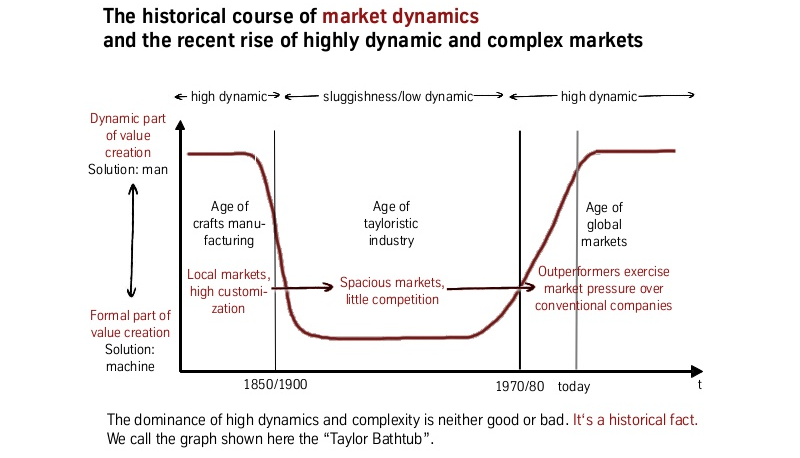
Niels Pflaeging in the book “Organizing for Complexity” mentions Taylor, stating that there are still many of his ideas in 21st-century companies.
The Taylor Bathtub or the Bathtub Curve is a graphical representation of the life cycle of a product or technology.
In Taylor's view, the new type of organizational science is nothing less than a "revolution" that would end the productivity constraints of the industrial age. An organizational system established by Taylor gave wings to the industrial age's quest for efficiency.
During the twentieth century, Taylor's scientific management was the basis for management.
Niels Pflaeging argues, however, that over time, the simplicity of this model in organizations compensated for the social gaps with hierarchical divisions, the functional gaps with fragmented responsibilities, and the time gaps between thinkers and nonthinkers.
The curve is divided into three distinct phases: the early failure phase, the useful life phase, and the wear-out phase.
The early failure phase represents the period of time when a high number of failures occur due to manufacturing defects or design flaws.
The useful life phase is the period of time when the product or technology is operating at its intended level of performance with minimal failures.
The wear-out phase is the period of time when the product or technology is approaching the end of its useful life and the likelihood of failure increases again.

"... Many companies have made the shift to become more decentralized. Many more were born that way and have reasonably maintained radical decentralization as they grew, resisting the tendency to turn themselves into pyramids..." - ManagementQuotes
The curve is commonly used in reliability engineering and product design to predict and plan for the product's life cycle and identify areas where improvements can be made to increase the product's longevity.
As the graph shows the historical trajectory of market dynamics and the recent growth of complex markets, it is referred to by Niels Pflaeging as the "Taylor Bathtub."
It symbolizes the market's dynamism between the 19th, 20th, and 21st centuries.
Following a century of inventive strength put to the service of mass, standardized production, with large markets being explored among few competitors, until the beginning of the twenty-first century, when a globalized market, open and accessible technology, and customer-centered approaches were introduced.
Classical management, however, was forever changed by one factor. That one factor is complexity.
"... Those days are gone. High-dynamic value creation re-emerged around the 70s, due to the rise of global, high-competition markets and the return of more individualized demand that made customization paramount and enabled mass customization. High-dynamic value creation, in turn, calls for an increase in the human part of problem-solving processes..." - Niels Pflaeging
Older models become roadblocks. A significant level of transformation is required for organizations to enable the current dynamic to be absorbed.
The decision-making process must be drastically decentralized. Essentially, they need to learn how to be agile.
In conclusion, understanding the Taylor Bathtub curve is not only crucial for product and technology development, but also for organizational development and leadership.
By predicting and planning for the future of a product, organizations can improve the reliability and longevity of their products, and ultimately improve their bottom line.
As Niels Pflaeging puts it, "it's not about avoiding failure, but about managing and leading it."
References, inspirations, recommendations, or further reading:
- Competition, Complexity, and Why Traditional Management is Dead
- Presentation Niels Pflaeging – The Taylor Bathtub
- Organize for Complexity, book by Niels Pflaeging
I am incredibly grateful that you have taken the time to read this post.
Your support and engagement mean the world to me, and I truly appreciate your interest in the topics I write about.
I hope that you have found this post informative, educational and engaging.
If you are interested in reading more of my work, please visit other articles here on the website.
I promise to continue providing valuable and high-quality content for your enjoyment and education.
Thank you again for reading and I hope to see you soon!
Here are some related articles you may enjoy:
There are even more good things I've prepared for you!
Subscribe below or click here to receive new posts in your Email!
Do you want to read some book notes and recommendations? Discover more here!
Do you want to have amazing weekly content curation? Discover more here!
Ready to make a positive impact?
Support my work by sharing my content with your network.
Your simple act of kindness can reach new heights and help spread valuable information.
Want to show your support in a tangible way? A virtual coffee is a small but mighty way to show your appreciation and give me the extra energy to keep crafting valuable content!



